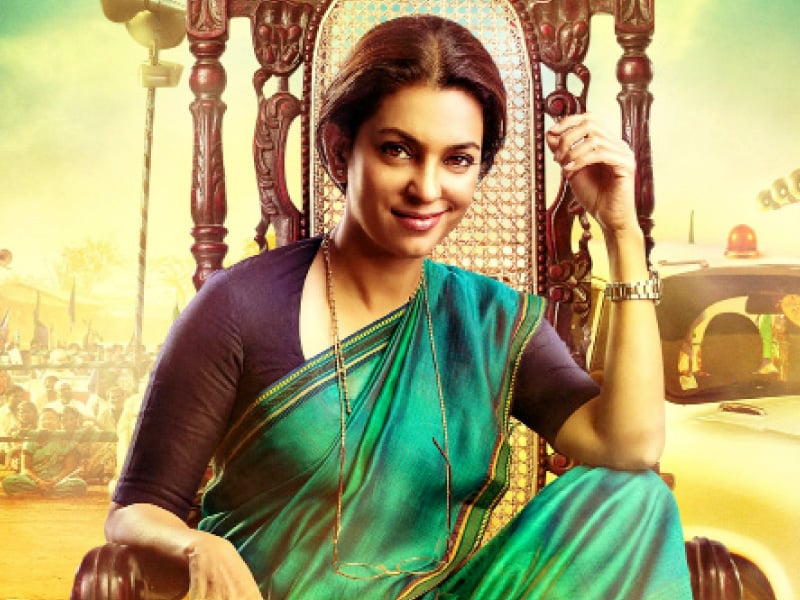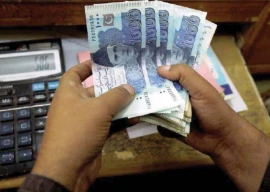
The one thing that you have to know about Juhi Chawla is that she is exactly as vivacious and outgoing in real life as she is on reel. Now for the first time in her nearly three decade long career, Bollywood’s angelic beauty can be seen as an antagonist in her latest release Gulaab Gang.
In this film, her character of Soumitra Devi wages war against Madhuri Nene’s fearless Rajjo. It is a rare thing to see a Bollywood vehicle that is carried solely on the shoulders of female leads, for despite the advances that the B-Town business has made in recent years, it is still a male-driven industry.
Speaking to The Express Tribune, Juhi had much to say on the prevalent notion that a leading man is an important staple in a Bollywood film. “All the distributors and financiers said the same thing when Gulaab Gang was in its initial stages. ‘Where is Shahrukh [Khan]? Where is Aamir [Khan]? Where is the male hero? How can the film work?’ But the film does work, because the script is so powerful. Is mein dum hai (It has strength). That is what makes it unique, not the lack of a leading man.”
Juhi credits director Soumik Sen’s indomitable will for the film eventually being made. “The directors and the producers said we will make the film the way we want to. They didn’t compromise on their vision in response to external pressures.” Judging from the early reviews, it is a vision that is garnering a fair amount of critical acclaim.

Speaking of pressures, Juhi herself felt susceptible to the strain of taking on a villainous avatar for this film, a move that is unprecedented thus far in her career. “I said ‘I’m not playing that character!’ I’ve always played cute and bubbly and sweet my entire career. But when I met [director] Soumik ji, he showed me the film through his eyes, and I saw the larger picture. It was then I realised what the film could be, and the zing that the script had.”
“The director could have taken an actress who was already known for villainous roles, but he chose me,” she adds. “That was something special and unexpected, for me and the film.”
It appears that Sen’s casting coup is paying off in spades, for Juhi’s turn as the nefarious politician Soumitra is being touted as one of the highlights of the film. “I feel very happy [with the reviews]. In terms of length my role is not big, but it appears that it has had a large impact.”
Given that she had earlier likened Madhuri’s Rajjo to Amitabh Bachan, who does she feel Soumitra Devi is comparable to? “Me?” she laughs, “I’m the Gabbar Singh [the antagonist of the 1975 film Sholay] of Gulaab Gang!” Much like the sadistic dacoit Gabbar Singh became a star of Indian cinema in his own right, Juhi feels that Soumitra Devi is a villain for the ages.

Juhi has previously been completely candid about the fact that Madhuri and she shared a rivalry during the 90s. Given that the women have to play characters at odds with one another in this film, did the competitive spirit they once shared help her get into the character of Soumitra? “The character herself is so fascinating – she is conniving, and scheming. I enjoyed getting into the role itself, the rivalry did not help or hurt the process.”
It did, however, lend something else to the film. “Madhuri and I began in the industry at almost the same time. It has been almost 27 years, and today for us to come together in a film is special. I feel that Gulaab Gang just wouldn’t have the same spark with any other actor. She does her role very well. I was convinced that this was going to be a masalaydaar (spicy) package!” she laughs.
She shares an anecdote about filming the climax of the film – a scene that is immortalised on the official poster of the film. “It is holi and Madhuri’s gang has been celebrating, but they know that Soumitra is coming to meet them. I arrive and I put rang on Madhuri’s cheek in a sinister and mean way. It was a director’s moment, two actresses facing off. Soumik got caught up and allowed the shot to go on. Suddenly he said ‘Madam! Look right!’ And neither of us knew which madam he was talking to! I didn’t know if he meant my right or camera right, and Madhuri and I broke out laughing in the middle of the intense scene. It was such moments that made filming really special. We wished the behind-the-scenes camera had been rolling!”
It is no secret that Gulaab Gang has seen its share of controversies pre-release. The Delhi High Court passed a stay order effectively stopping the release of the film after Sampat Pal, citing similarities to her Gulabi Gang - a group of Indian women vigilantes and activists originally from Bundelkhand, Uttar Pradesh - filed a case against the film-makers. Pal claimed that the film was ‘defamatory’ and would cause a “loss of reputation that could not be compensated by monetary terms.”
Of the controversy, Juhi says, “The name of the film is inspired by Gulabi Gang, and the women in the film wear magenta saris. The similarities stop there. The film is completely different from their story. It is masala and commercialised and an amalgamation of many different stories.”
Addressing Pal’s claims that the film is defamatory to her life’s story, Juhi says, “Madhuri’s Rajjo is such a righteous character. She stands for women empowerment and education. She tries dialogue first and only resorts to violence when she has no other choice. There is nothing negative about the character.”
Setting the record straight about Madhuri’s gang in the film, Juhi says, “I had my own little gang of evil people too! Her’s is most women but mine is not. All the people at my party office - the policemen, my secretary, the election officer - are men. The cast is largely female, but not entirely made up of women.”
Juhi sees a positive change in the Bollywood industry as a whole when it comes to gender disparities. “In the 90s, there were just 2 or 3 women that could be seen on set during a production. Sometimes it would just be the female lead. My mother would accompany me on set sometimes and it would be just me and her. Now, when you look around a cast and crew, from the make-up artist and hairstylists, to the directors, PR people and managers, there is a wonderful change. Gender equality is already happening, and in all the departments.”
She firmly believes that there cannot be a replacement for what a women brings to the screen. “The person who brings beauty, love and warmth on the screen is the female. Any film is incomplete without a female character. Never think ‘Oh I just played a doll face!’ Never think a part is minor or insignificant, because the audience will not like the film without that doll face!”
Published in The Express Tribune, March 16th, 2014.
Like Life & Style on Facebook, follow @ETLifeandStyle on Twitter for the latest in fashion, gossip and entertainment.
COMMENTS (4)
Comments are moderated and generally will be posted if they are on-topic and not abusive.
For more information, please see our Comments FAQ












































good movie :@
Excellent movie. Never enjoyed more!
Third Class Movie
C class movie. Both Juhi and Madhuri were not suitable for their characters.